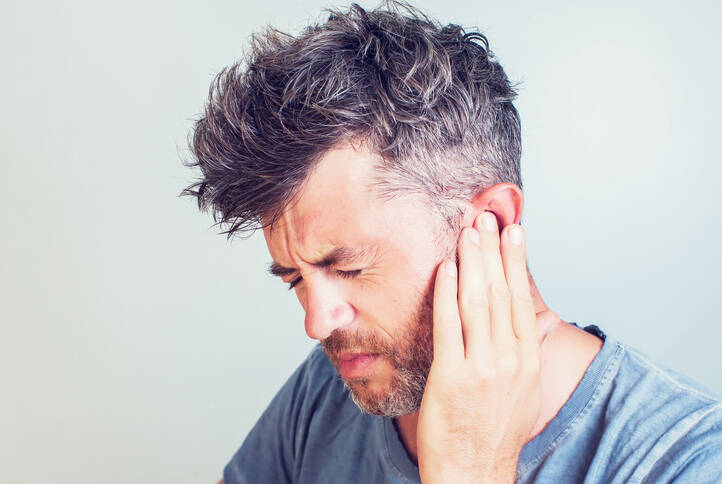Inflammation, pain or itching of the ear in summer? From water, draughts and air conditioning

The onset of summer weather often tempts us to the water. Few people can resist the urge to cool off in lakes or swimming pools. Sometimes, however, such refreshment also brings the unwanted gift of an ear infection. In this article, we take a look at what causes it and how it is treated.
Article content
Let's look at all the summer problems together:
Our health in summer - sun, heat, injuries and illnesses
Ear infections - otitis
Professionally, ear inflammation is called otitis. It is divided into otitis media and otitis externa.
Otitis media
Otitis media is closely related to diseases of the upper respiratory tract, due to their anatomy and function. It is often associated with their associated diseases. It is most often found in pharyngitis and rhinitis.
In children, the auditory tube is still short, so otitis media is often associated with childhood. However, it does not avoid adults either. It is defined as acute onset of symptoms associated with inflammation and the presence of fluid in the middle ear.
Up to 90% of children overcome otitis media by the age of 6.
The course of the disease is not uniform, especially at different ages. In young children under 1 year, general symptoms such as:
- fever
- lack of appetite
- vomiting
- weight loss
The pain in the ear is brought on by crying. It also causes insomnia. It is primarily caused by a virus, to which a bacterial infection is added.
In a typical course, there are pronounced symptoms in adults and otitis media is easily diagnosed.
After and often during acute pharyngitis, there is increasing ear pain and there may be hearing loss on the affected side. The ear canal tends to be filled with purulent fluid.
Otitis media in adulthood is sometimes a recurrent inflammation from childhood, which the affected person may not have known about.
When it manifests itself, one must simultaneously think about their treatment, as it is an associated disease of inflammation of the upper respiratory tract. If improper, this inflammation could become chronic and seriously damage the hearing of the affected.
Read also: article about otitis media.
An article on otitis externa or swimmer's ear
Inflammation of the outer ear or swimmer's ear has both external and internal factors.
The external ones include:
- maceration of the skin - that is, wetting of the skin with fluid, especially water from swimming pools and water tanks in summer, or directly with inflammatory fluid
- mechanical damage to the skin
- chemical damage to the skin
This reduces the elasticity of the skin of the external ear canal. This results in a reduction in the function of the sebaceous glands located there. This reduces the production of fatty acids, which are part of the earwax and serve as a prevention against microorganisms.
Its protective function is therefore reduced and the ear canal becomes more susceptible to infections.
Also, frequent washing of the ear canal with soap or shampoo washes out the earwax and prevents it from fulfilling its function. The skin becomes dry and unwanted bacteria can easily settle on its surface. Dusty environments and excessive humidity are also a big problem.
A highly infectious environment that has a large and frequent influence on otitis externa is swimming pool water. Especially thermal water, which contains chlorine and bacteria of the genus Pseudomonas aeruginosa.
The result is frequent otitis externa (inflammation of the ear), also known as swimmer's ear, which occurs mainly in summer and affects all ages.
However, children are more susceptible to this disease due to their prolonged exposure to water and associated activities.
They are at an increased risk of water entering the ear canal and staying there for a longer period of time. This is possible due to its anatomical shape, which slopes slightly downwards from its midpoint inwards towards the eardrum.

Ear infections are often caused by unnecessary and excessive mechanical cleaning of the external ear canals and removal of earwax.
The improper use of cotton buds prevents the self-cleaning process of the ear. The sebum is pushed up to the eardrum by the rod, where it dries and acts as a foreign body.
This causes irritation of the skin in the ear canal and inflammation.
Draughts and colds are a common contributing factor. Open windows, even while driving, air conditioning or fans can help.
- What effect does air conditioning have on our health? Can it be harmful?
- How to use or adjust the air conditioning correctly and not to harm us?
The internal factors for the development of ear infections include, in particular, conditions leading to a weakening of the organism. These are various acute or chronic diseases:
- Diabetes
- reduced vitamin levels
- frequent physical overload
- frequent exposure to stressful situations
Symptoms of otitis externa
It all usually starts with itching in the ear canal. However, this is not usually given much importance. However, the itching itself is a low-level pain. This becomes more acute over time and the sufferer finds that relieving himself by scratching his ear is no longer enough.
Often the aforementioned cosmetic sticks are used, making the course of the disease even worse. The pain is localised to the external ear canal and is increased by retraction of the ear lobe or by pressure on the cartilage of the ear where the ear canal emerges (the so-called tragus). It is particularly intense at night.
This is caused by swelling of the ear canal and inflammatory fluid in the ear canal. If it has not been removed for a long time, it may smell unpleasant. The ear canal may be so swollen that it cannot be properly examined.
The pain may increase if the inflammation has begun to spread to the cartilage or periosteum. Ear canal inflammation is often associated with enlargement of the underlying lymph nodes and pain in the area behind the pinna.
Symptoms of otitis externa vary. The most common include:
- pain in the ear canal area
- itching, pressure or other discomfort in the ear area
- discharge from the ear
- hearing loss
- swelling in the ear canal and/or pinna
- increased body temperature
- enlarged relevant lymph nodes
The table below shows the differences between otitis externa and otitis media
| Otitis externa | Otitis media |
|
|
Forms of acute otitis externa
Acute otitis takes different forms.
It may be a circumscribed otitis externa, in which case it is a circumscribed inflammation of the external ear canal, located in some part of the ear canal.
Diffuse otitis externa is a pervasive inflammation that affects the entire ear canal. It affects the skin of the ear canal and deeper in the bony part of the ear canal. It can be bacterial but also mycotic. Symptoms include:
- pain, which may not be intense
- swelling
- hearing loss
- oozing pus, which causes etching and inflammation of the skin and the pinna
Unlike otitis media, those affected do not have a persistent elevated body temperature.
Viral otitis externa is most common in influenza epidemics, but is also caused by herpes viruses. Sufferers have intense ear pain and mild hearing loss. Blood-filled blisters form in the external ear canal. These are surgically incised and symptoms are relieved.
Malignant otitis externa may occur in immunocompromised patients, those with severe diabetes or cancer patients undergoing chemotherapy.
The inflammation initially manifests as acute otitis externa, which progresses to chronic inflammation. Later, it begins to destroy the bone of the ear canal and can cause facial nerve paralysis.
Mycotic otitis externa occurs in people who spend prolonged periods in damp environments. It is caused by various fungi and moulds. The skin of the ear canal develops plaques that vary in colour from yellow to greenish-black depending on the type of mould. Itching of the ear canal and hearing impairment occur.
Treatment of otitis externa
Treatment depends on the causative agent of the inflammation.
If the inflammation was caused by bacteria, then daily topical treatment is resorted to with agents that induce a change in the acidity of the environment. That is, those that change the environment of the ear canal to acidic:
- 3% boric acid solution with alcohol
- Burrow's solution
- chloramine rinses
Broad-spectrum antibiotic solutions may be applied topically. If the inflammation does not subside, antibiotics are also administered systemically according to the results of blood tests.
Mycotic inflammation is treated by daily cleaning and suctioning of the ear canal. Antifungal solutions are applied or antifungal agents are administered systemically. In addition to regular treatment, treatment of these inflammations requires follow-up for at least 2 weeks after symptoms have disappeared. Antifungal agents are administered topically to prevent recurrence of the disease.
Inflammation caused by the herpes virus is treated with antivirals, B vitamins and corticosteroids.
As all otitis externa is accompanied by unpleasant pain, the treatment is also accompanied by the administration of painkillers (analgesics).
Short video about the swimming ear
Related










